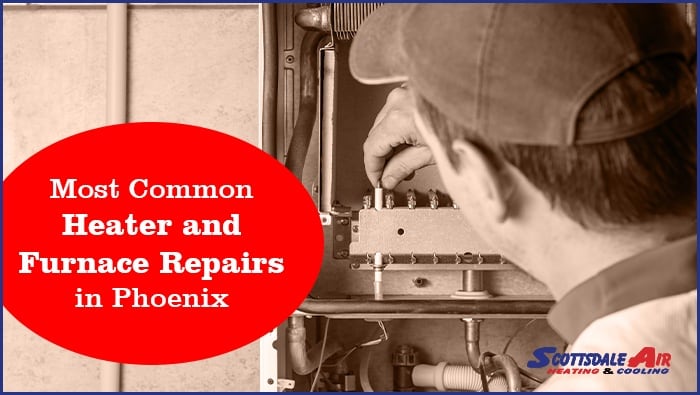The average life expectancy of a furnace is around 16-20 years, but this number can decrease if you don’t take good care of your appliance.
As a homeowner, it is your job to recognize when your heating system is malfunctioning.
It is then important to get the proper care for your appliance to keep it working for years to come.
Some signs of a problem with your furnace are obvious, while others require a little more digging.
Read on to learn more about the common heater and furnace repairs that you may run into.
Cracked Heat Exchanger
The heat exchanger is where all of the warm air comes from inside of your heater.
This exchanger is comprised of many different heated tubes that work to push the hot air into your home.
If you notice that the heat coming out of your vents is not very warm, then there could be a problem with your heat exchanger.
Unfortunately, this can be a very expensive repair, so make sure you are keeping up with your routine HVAC maintenance to prevent this from happening.
Dirty Ductwork
It is very easy for dust and other debris to make their way into your ductwork.
This can impact your health and also decrease the hot air you receive from your heater.
Your HVAC technician can usually test, clean, or repair faulty ductwork in your home, so make sure you ask them about this during their routine visit.
Strange Smells
One of the most common heater problems is experiencing strange smells.
While this is a common problem, it should be addressed immediately.
A musty smell could indicate mold, while a metallic smell could be a sign of a gas leak or other dangerous issue.
If you suspect a gas leak in your home, it is essential to call emergency services immediately.
Failing Pilot Light
The pilot light in your furnace kickstarts the entire heating process.
If there is a problem with the pilot light, then your furnace may not turn on.
If you notice that your pilot light has changed color, gone out, or is flickering, then call your local HVAC technician.
Your pilot light may turn off for something as simple as clogged ducts or for something as serious as a carbon monoxide leak.
Clogged Filters
One of the most common furnace problems is clogged filters.
Every furnace has a filter that keeps the air and your ductwork clean.
If you fail to change this, then you are breathing in dirty air and filling your furnace and ductwork with debris and dust.
If your furnace seems to be working harder than usual, then it may be struggling to get air through a dirty filter.
A good rule of thumb is to change your filter every three months or so.
Broken Blower Belt
A broken furnace blower belt is something you should never ignore.
If your furnace is making a high-pitched shrieking sound, then your blower belt is likely to blame.
The blower belt helps to keep the fan inside of your unit running, so keeping it working properly is essential.
Sometimes, it simply slips out of place and needs to be placed back on the track.
Other times, it may completely snap or fray, which requires a replacement belt.
Malfunctioning Limit Switch
The limit switch detects the heat level in your furnace and tells the blower fan when to turn on and off.
It can prevent your furnace from overheating, which can be dangerous to your home.
If you need a limit switch repair, then your furnace will likely run continuously, even when it shouldn’t.
This can be easy to spot during the hot Phoenix summers.
If it’s hotter than normal in your house, then you may want to check the limit switch.
Loud Noises
Your furnace always makes some sort of noise, but any unpleasant noises should be investigated further.
If you hear loud rattling noises inside of your furnace, then something may have come loose in the unit.
A low rumbling sound could indicate that there is a problem in your ductwork or that your furnace is failing altogether.
As mentioned before, a squealing or scraping sound could indicate a problem with the blower belt.
Thermostat Not Working
Sometimes the problem isn’t with the furnace or heater itself.
Your thermostat detects the amount of heat inside of your home and therefore tells the heater when to turn off and on to regulate the temperature.
If your thermostat isn’t working, then it may pick up the wrong temperature and tell your furnace to turn off and on at the wrong times.
One common sign of a failing thermostat is that the fan is constantly running.
Try changing the heat settings and see if the fan stops or starts.
If it doesn’t, then your thermostat may be the problem.
Tripped Breaker
Another non-furnace-related problem could be a tripped circuit breaker.
If there is a temporary power surge, then your breaker may get tripped and cause your furnace to stop working.
Usually, you can reset the circuit breaker and fix this problem without much of an issue.
If this issue persists, however, then you may have a bigger electrical problem within your home.
An HVAC expert can evaluate this and let you know what steps to take next.
Be Aware of These Common Heater and Furnace Repairs
So, now you know the signs that you need heater and furnace repairs.
Keeping your furnace in good condition is essential to extending the life of your appliance and keeping your home comfortable.
If you enjoyed this article and want to learn more about heating services near me, then feel free to contact us with any questions or concerns.
_________________________________________________________________________________________
Is your heating system showing signs of malfunctioning? Look no further than Scottsdale Air Heating & Cooling. We are a top Phoenix HVAC company specializing heater and furnace repairs, and have been helping homeowners keep their HVAC units running at peak performance for over 75 years! Call 480-945-7200 or request service online! …*Yes, We DO offer Financing Options.
Read more articles about Heating & Cooling:
- Fall HVAC Prep: Heat Pump Maintenance Tips for Scottsdale Home Owners
- Looking for an Air Conditioning Repair Company In Scottsdale?
- Air Conditioner Compressor Replacement Guide





